|
Related FAQs: Corallimorphs, Mushrooms 2, Mushrooms 3, Mushrooms 4, Mushroom Identification, Mushroom ID 2,
Mushroom ID 3, Mushroom ID 4, Mushroom ID 5, Mushroom ID 6,
Mushroom ID 8,
Mushroom ID 9, Mushroom ID 10,
&
Mushroom Behavior, Mushroom Compatibility, Mushroom Selection, Mushroom Systems, Mushroom Feeding, Mushroom Health, Mushroom Disease 2, Mushroom Reproduction,
Stinging-celled Animals,
Related Articles: Cnidarians, Water Flow, How Much is Enough,
/A Diversity of Aquatic Life
Coral Anemones, False
Corals, Mushrooms: Order
Corallimorpharia; part 1
To: part 2, part 3
|
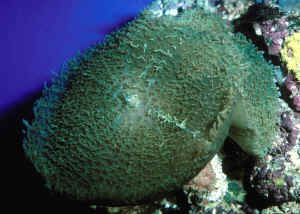
|
|
By Bob Fenner
|
Two Amplexidiscus in captivity
|
Coral anemones, mushroom anemones or false corals are
perhaps the most celebratedly hardy "corals"; often
reproducing readily in well-kept systems. They have much to their merit
besides, being relatively inexpensive and available in reds, blues,
greens, purples and variegated patterns. Corallimorpharians require
little specialized care as you will see.
Classification: Taxonomy, Problems, Relation With
Other Groups
Coral anemones are closely related to the stony or true
corals, indeed they are sometimes grouped as part of the same Order
(Scleractinia) as a sub-order. One arrangement:
Phylum Cnidaria:
Phylum Cnidaria: Stinging-celled animals. Anemones,
corals, sea fans, jellyfishes, sea pens... Polyps and/or medusae
stages
Class Anthozoa:
Class Anthozoa: Polyp stage only, stomach divided
in numerous compartments.
Sub-Class
Zoantharia (Hexacorallia): More than
eight and multiples of six tentacles.
Order Corallimorpharia:
Coral anemones. Solitary or colonial, flattened mushroom-like
anemones. Short, stubby tentacles radially arranged. Look like
true corals, but lack skeletons. About ten families. Most common
genera Actinodiscus, Ricordea, Corynactis, Rhodactis,
Amplexidiscus. (the last two can eat unwary fishes...
commonly clowns) Individual polyps 1 inch to 1 foot
across.
|

|
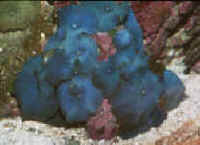
|

|
|
Stippled, smooth, to fuzzy and striped, the
most common Corallimorphs comprise the genus
Discosoma/"Actinodiscus"
|
|
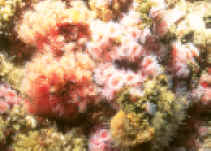
|

|
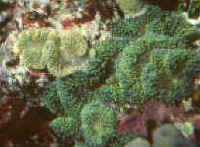
|
|
Corynactis, cold water
only A Pacific Ricordea under culture
Ricordea
floridae
|
|

|

|

|
|
Potential and actual fish eaters, the larger
Corallimorph genera Amplexidiscus (above and left) and
Rhodactis
|
Commonly Encountered
Corallimorphs:
Genus Amplexidiscus:
| Amplexidiscus fenestrafer Dunn & Hamner
1980. The Elephant Ear. Indo-Pacific. To about eight inches in
diameter in captivity, two feet in the wild. These ones
photographed off Pulau Redang, Malaysia. Below, In N. Sulawesi
(Lembeh Strait); a close-up with a Pliopontonia furtiva
shrimp on it. Monotypic genus. |
 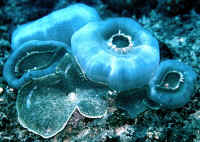
|
Bigger PIX:
The images in this table are linked to large (desktop size) copies.
Click on "framed" images to go to the larger size. |

%20MD.JPG)
%20MD.JPG)
%20MD.JPG) |
Genus Corynactis:
| Corynactis californica. A cool to coldwater
Corallimorpharian found off Mexico and the U.S. California
coasts. |
 |
Bigger PIX:
The images in this table are linked to large (desktop size) copies.
Click on "framed" images to go to the larger size. |
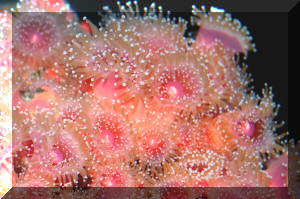
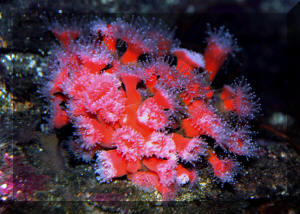
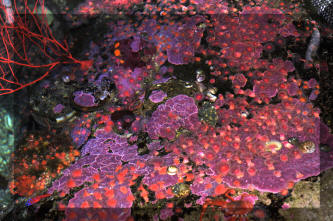
%20MD.JPG) |
To: part 2, part 3

